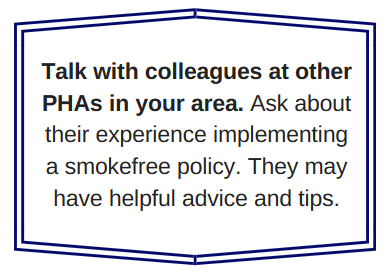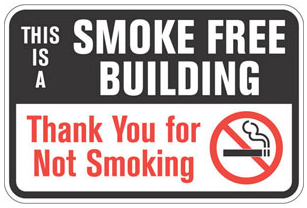The U.S. Department of Housing and Urban Development (HUD) adopted a smokefree rule that went into effect on February 3, 2017. The rule requires Public Housing Agencies to adopt and implement a policy that prohibits smoking in all public housing properties within 18 months (by August 2018).
The steps outlined below can help your Public Housing Agency (PHA) implement a smokefree policy for your public housing properties. Did you know that more than 600 PHAs have already implemented smokefree policies? You are in good company and there are many helpful lessons learned to support you in the process of implementing your policy.
◊ Getting Started:
Start planning now. It is wise to take time to thoughtfully plan and implement a smokefree policy. The PHA, staff, and residents need to take the necessary steps to be ready for the transition.
Learn the details of HUD’s smokefree rule, which prohibits smoking tobacco products in all public housing buildings, including units and common areas, and within 25 feet of buildings.
Evaluate your existing policy. If your PHA already has a policy about smoking, you may need to update it to meet HUD’s new requirements.
Learn about local or state laws that may have smokefree requirements for multi-unit housing. Contact ANR Foundation or your health department’s tobacco control program to learn more. For example, addressing electronic cigarette use (vaping) is optional under HUD’s rule, but some local and state laws prohibit the use of these products in common areas and/or units.
Read HUD’s implementation guidance and Change is in the Air Action Guide, which both have helpful information for PHAs on how to implement and enforce your new policy.
Contact your health department to see if the tobacco prevention program or other local organizations can provide assistance, such as flyers to educate residents, signs for your building, or smoking cessation information.
See our model smokefree policy language, which is specifically designed for PHAs to use to implement HUD’s rule.
◊ Involve all staff. PHA staff, building managers, maintenance staff, resident councils, resident services, and other entities working at your properties should all be involved in discussions and the planning process for the policy, including enforcement. Take time to gain staff and manager buy-in early in the process because they will be on the front lines of enforcement. Schedule your implementation plan by working backwards from your building(s) selected effective date.
◊ Survey residents to get their thoughts about secondhand smoke exposure in and around the building, and to learn about their questions and concerns about having a smokefree policy. Hearing from residents can help you move forward in an informed manner.
◊ Educate residents about secondhand smoke and notify them that the PHA is starting the process of adopting a smokefree policy for all buildings. Educate residents about the health risks posed by exposure to secondhand smoke, that smoke can drift through buildings and harm the health of other residents, and that smoking in the building increases the risk of fire. Remind them that there is no safe level of exposure to secondhand smoke. Let them know that a smokefree building creates a healthier and safer living environment for all residents by improving the indoor air quality and reducing the risk of fire. Learn more about talking with residents about the smokefree policy.
◊ Decide on the details. HUD’s rule has minimum requirements and PHAs have the choice to include additional provisions, such as not allowing smoking on the property, creating an outdoor smoking area, and not allowing the use of electronic cigarettes (vaping). Be sure to include any provisions required by local or state laws. HUD recommends involving residents in the process of designing the policy details, such as locations of signs and the location of any designated outdoor smoking areas. Use the ANR Foundation’s model policy language to help you adopt your policy.
◊ Choose the effective date. Decide the date(s) when the building(s) will go smokefree. You can choose whether A) the policy will go into effect on one date for all residents, or B) the policy will roll out over time as residents sign lease renewals. The policy must be in effect for all residents by August 2018.
◊ Update the PHA plan. Follow HUD’s standard requirements when amending PHA procedures and policies. Get approval from your board for the new policy and add the policy to your PHA plans. If the policy is a significant amendment, rather than a modification, public meetings should be held. See HUD’s implementation guidance and Change is in the Air Action Guide for details.
◊ Create a smokefree lease addendum. Use our model lease addendum to help you write your addendum. Decide on a process for having all residents sign the addendum by the effective date of your building’s policy.
◊ Develop a compliance plan and train staff. Work with Resident Councils to agree upon progressive enforcement steps. Make sure all property managers and staff are trained on why the policy is being adopted, policy details, how compliance and violations will be addressed, and everyone’s roles and responsibilities. Provide written information about the policy and how to talk with residents. Address questions and concerns, and seek input on likely resident questions and challenges.

◊ Communicate your policy with residents. Send residents a letter to let them know about the upcoming policy change: explain why the policy change is being made, the details of the policy, how complaints and violations will be addressed, and the effective date. Hang up a flyer about the new policy in the lobby and on each floor. It’s helpful to communicate in writing, in person, and at meetings. Remind residents that a smokefree policy does not mean that people who smoke need to move out or need to quit smoking; rather it simply means that they cannot smoke in the specified areas. Have information available in multiple languages if necessary.
◊ Hold resident meetings to discuss the policy prior to implementation. Meetings provide an opportunity to explain the scope of the policy (where smoking is and is not allowed), what is expected of residents and their guests to comply, and how management will address any violations. Meetings allow residents to ask questions and raise concerns, so you can clarify misconceptions and answer questions. Announce meetings in advance by mail and flyers. Consider holding meetings at several different times (weekday evening; weekend morning) to increase the ability of residents to attend. Have bilingual staff present if necessary. See our tipsheet on talking with residents about your building’s smokefree policy.
◊ Connect residents with smoking cessation resources. Contact your local health department to learn what cessation resources are available in your community for residents who might be interested in quitting smoking. Offering cessation helps residents feel supported and not attacked by the policy change.
◊ Have residents sign the smokefree lease. Residents must be notified in writing at least 60 days before they need to sign the addendum. You can have all residents sign the addendum at the same time, or on a rolling basis when residents recertify and sign new leases, as long as the policy is in effective by the August 2018 deadline. Schedule appointments to sign the addendum, or have multiple opportunities for residents to sign the addendum in the leasing office, lobby, or community room. Announce these times in advance by mail, email, or flyers. Explain the policy to incoming residents and have them sign the addendum.

◊ Post signs. Order smokefree signs in advance of the implementation date in as many languages as needed. Post signs in visible areas at building entrances, in common areas, and in outdoor locations. Signs are an important part of achieving compliance by letting residents, guests, and staff know exactly where people can and cannot smoke.
◊ Implement your policy. Send residents a reminder about the policy just prior to the implementation date. Make sure all residents have signed a lease addendum, replace any old signs with new ones, remove cigarette butt receptacles from within 25 feet of doors, and clean up cigarette butts. Most people comply with smokefree policies when they know what is expected.
◊ Celebrate Implementation. Hold a celebration on the day of implementation to acknowledge the change and the positive benefits of the building becoming smokefree. Have music, food, smoking cessation information, and a drawing for prizes. Prizes may have little cost, but can appeal to residents, like a grocery store gift card, pair of movie tickets, or use of the community room. A prize drawing may also serve as an incentive for residents to sign the addendum on time. Some PHAs have held a drawing for residents to get their unit-re-painted or have new carpet installed.
◊ Enforce the policy change. The goal is to set the expectation of good compliance. A smokefree policy can be enforced like any other lease provision or house rule. Have consistent procedures in place for addressing complaints and follow through on all reported violations. Let residents know how they can report a suspected violation. For information about enforcing your smokefree policy, see Enforcement Tips for Building Managers and Maintenance.
◊ Promote your policy. Make it easy for new residents to know that your building is a smokefree living environment by advertising the policy on the PHA website, in brochures, at housing fairs, and in other listings. Advertising can help improve compliance by letting incoming residents know what is expected.
◊ Sustain compliance:
Continue to engage residents about the policy moving forward to address any concerns or issues that may arise.
Educate all incoming residents about the policy.
Consider if any changes need to be made to improve the process of addressing complaints and violations after your policy has been in effect for a few months.
Survey residents 6 months or 1 year after the policy is implemented. Ask similar questions to your initial survey to learn about exposure to secondhand smoke and compliance with the policy, and ask if people who smoke have cut down or quit since the policy went into effect.
Evaluate if cleaning costs, turnover time, and maintenance tasks have changed.
Celebrate the anniversary of the policy in recognition of having healthier living environments.
◊ Important Smokefree Public Housing Information:
HUD Smokefree Public Housing Rule
https://www.hud.gov/sites/documents/SMOKEFREEPHFINALRULE.PDF
HUD Memo on Smokefree Public Housing Implementation Guidance
https://www.hud.gov/sites/documents/PIH2017-03.PDF
Change Is In the Air: HUD’s Action Guide for Establishing Smoke-Free Public Housing
https://www.hud.gov/sites/documents/SMOKEFREEACTIONGUIDE.PDF
ANR Foundation Model Public Housing Smokefree Policy:
https://no-smoke.org/model-public-housing-smokefree-policy/
ANR Foundation Model Smokefree Lease Addendum
https://no-smoke.org/model-smokefree-lease-addendum/
More information is available from us at https://no-smoke.org/at-risk-places/homes/ or by contacting us online, calling 510-841-3032, or emailing info@no-smoke.org.
May be reprinted with appropriate credit to the American Nonsmokers’ Rights Foundation.
Copyright 2017 American Nonsmokers’ Rights Foundation. All rights reserved.
